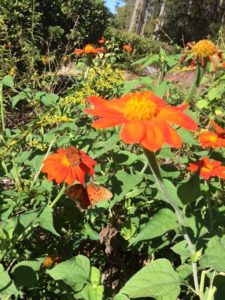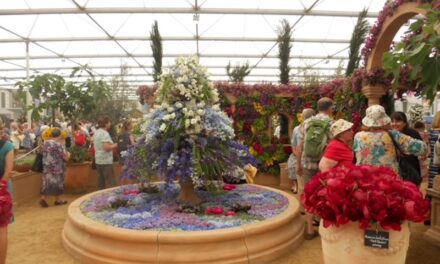
Tithonia
Audrey Hepburn once wrote “To plant a garden is to believe in tomorrow.” And at this dark and cold time of the year, truer words were never written. I use this season to plan and plot out what to plant. I do a lot of “creative staring” at my garden to figure out what will look good in the spring. I am hopeful that my perennials will come up and flourish once again, and since there is always room for more plants this year I am planting quite a lot of seeds.
Seeds are a very inexpensive way to add to your garden. For a three-dollar packet of seeds, you will get numerous plants. You also will have a much better selection when you order from a seed company than what you will find at our local nurseries.
Seed catalogs have seeds for vegetables, herbs, and flowers. Some even carry seeds for ornamental grasses.
This year I am starting many of my seeds inside. I have found that take out and party platter containers make great mini greenhouses – especially the ones with the clear plastic lids. Poke some drainage holes in the bottom and a few slits to make an opening for ventilation in the clear top. I use seed starting mix that is available at any big box store. I will be starting seeds indoors around the middle of February. Our last frost date is usually March 15th and most seeds need around 4-6 weeks to germinate and to produce second leaves so that they are big enough to plant out.
Soil temperature is important and when the soil temp gets up to 50, it is safe to plant things.
Seed packets will give you a time frame as well as a germination rate. They may also tell you how long before the plant matures and flowers. A sunny windowsill is all you need, but on warm days a porch or deck can be a nice little vacation for your seedlings. Once they have some leaves, you will need to acclimatize your seedlings by “hardening off.” This is putting them outside in a part shade, part sun area so that they can get used to being out in the open air and sunlight.
All of my zinnias are grown from seed as well as Mexican sunflower (Tithonia) and ageratum. I direct sowed this past year and due to a colder than normal March, it took awhile for my flowers to bloom. My ageratum bloomed all last winter. This year, our hard freeze Christmas weekend killed them off. Do not be put off by the commonness of marigolds. There are some new varieties that are stunning with white, red, or mixed color blossoms. They are not your grandmother’s marigolds. In fact, every year, growers offer new cultivars of old classics that will amaze you. How about a lime green zinnia with a magenta center? That will be a showstopper.
I do not tidy up my garden until the end of February. I leave up the dried grasses and perennials to provide habitat for hibernating insects. The seedpods are enjoyed by the birds. I have grown to like the looks of the dead plant material. It provides winter interest rather than bare ground.
The winter is also a good time to put down compost to enrich your soil. I buy bags of mushroom compost. It is inexpensive and tends to be alkaline in nature and that is beneficial since our soil tends to be acidic. A good layer of compost as a mulch protects my plants as well as gives them nutrients to get a nice head start in the spring. Composted cow mature is also a good product to use as well.
I plan on expanding one of my flowerbeds to give my roses more room. My lawn keeps on getting smaller and smaller and that is fine with me. Turf grass really provides no ecological or environmental benefit so if I can slowly, but surely diminish the amount of lawn, so much the better. Americans seem to love their lawns much to the amusement of other parts of the world. The grasses that we have in our lawns are not indigenous to our continent. Kentucky Blue grass is native to Europe and northern Asia. The first settlers had to bring grass seed with them so that their livestock had something to eat. Who knew?
I really find winter a great time to work in the garden. As long as it is above 40 and sunny, it is so nice not to drip with the humidity and swat at bugs. I have also developed a more relaxed attitude towards the bad cold snaps that we do have. If something dies, it will give me a new space to fill with a new plant that might be more resilient to changes in temperature. That hard freeze did take out quite a bit of plant material, but I am optimistic that things will come back with warmer temps. I am now getting spring plant and seed catalogs and I can study up on what will be giving me pleasure in 2023. A Happy New Gardening Year!











